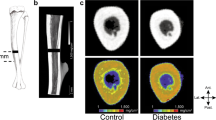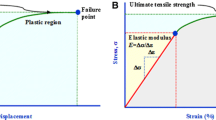Abstract
Introduction
Diabetes is associated with an increased risk of fracture, although type 2 diabetes is often characterized by normal bone mineral density (BMD). Enzymatic and glycation-induced non-enzymatic cross-links play important roles in the expression of bone strength. The serum vitamin B6 concentration is lower in patients with diabetes than in healthy controls. The aim our study was to see if spontaneously diabetic WBN/Kob rats in the pre- and post-onset of diabetes would serve as a suitable model for studying the pathogenesis of the susceptibility to fracture in diabetes without the reduction of bone mineral density. Seventy male WBN/Kob rats were obtained at the ages of 1 to 18 months.
Methods
Seventy normal male Wistar rats were used as the non-diabetic, age-matched control. The contents of enzymatic cross-links (dihydroxylysinonorleucine, hydroxylysinonorleucine, lysinonorleucine, pyridinoline and deoxypyridinoline) and non-enzymatic cross-links (pentosidine) were determined in femoral bone. We also analyzed the serum concentration of vitamin B6 (pyridoxal and pyridoxamine), femoral BMD and a three-point bending test of the femur.
Results
A low level of serum vitamin B6 was associated with a decrease in enzymatic crosslinking in bone during the subclinical diabetes stage. After the onset of diabetes, there was a steady decrease in enzymatic cross-links and a steep increase in pentosidine. Furthermore, impaired bone mechanical properties in the WBN/Kob rats despite the lack of reduction in BMD coincided with impaired enzymatic cross-link formation and increases in glycation-induced pentosidine.
Conclusions
These results indicate that the alteration of enzymatic and non-enzymatic crosslinking in bone could be important for explaining the variation of fracture susceptibility in diabetes.






Similar content being viewed by others
References
Schwartz AV, Sellmeyer DE, Ensrud KE Cauley JA, Tabor HK, Schreiner PJ, Jamal SA, Black DM, Cummings SR (2001) Older women with diabetes have an increased risk of fracture: a prospective study. J Clin Endocrinol Metab 86:32–38
NIH Consensus Development Panel (2001) Osteoporosis prevention, diagnosis, and therapy. JAMA 285:785–795
Viguet-Carrin S, Garnero P, Delmas PD (2005) The role of collagen in bone strength. Osteoporos Int, Dec 9; [Epub ahead of print]
Garnero P, Borel O, Gineyts E, Duboeuf F, Solberg H, Bouxsein ML, Christiansen C, Delmas PD (2006) Extracellular post-translational modifications of collagen are major determinants of biomechanical properties of fetal bovine cortical bone. Bone 38:300–309
Wang X, Shen X, Li X, Agrawal CM (2002) Age-related changes in the collagen network and toughness of bone. Bone 31:1–7
Saito M, Fujii K, Soshi S, Tanaka T (2006) Reductions in degree of mineralization and enzymatic collagen cross-links and increases in glycation induced pentosidine in the femoral neck cortex in cases of femoral neck fracture. Osteoporos Int, Mar 22; [Epub ahead of print]
Kuboki Y, Kudo A, Mizuno M, Kawamura M (1992) Time-dependent changes of collagen cross-links and their precursors in the culture of osteogenic cells. Calcif Tissue Int 50:473–480
Uzawa K, Grzesik WJ, Nishiura T, Kuznetsov SA, Robey PG, Brenner DA, Yamauchi M (1999) Differential expression of human lysyl hydroxylase genes, lysyl hydroxylation, and cross-linking of type I collagen during osteoblastic differentiation in vitro. J Bone Miner Res 14:1272–1280
Yamauchi M, Katz EP (1993) The post-translational chemistry and molecular packing of mineralizing tendon collagens. Connect Tissue Res 29:81–98
Saito M, Soshi S, Fujii K (2003) Effect of hyper- and microgravity on collagen post-translational controls of MC3T3-E1 osteoblasts. J Bone Miner Res 18:1695–1705
Saito M, Sohsi S, Tanaka T, Fujii K (2004) Intensity-related differences in collagen post-translational modification in MC3T3-E1 osteoblasts after exposure to low and high intensity pulsed ultrasound. Bone 35:644–655
Saito M, Fujii K, Tanaka T, Soshi S (2004) Effect of low- and high-intensity pulsed ultrasound on collagen post-translational modifications in MC3T3-E1 osteoblasts. Calcif Tissue Int 75:384–385
Vashishth D, Gibson GJ, Khoury JI, Schaffler MB, Kimura J, Fyhrie DP (2001) Influence of nonenzymatic glycation on biomechanical properties of cortical bone. Bone 28:195–201
Paul RG, Bailey AJ (1996) Glycation of collagen: the basis of its central role in the late complications of ageing and diabetes. Int J Biochem Cell Biol 28:1297–1310
Oxlund H, Mosekilde L, Ortoft G (1996) Reduced concentration of collagen reducible crosslinks in human trabecular bone with respect to age and osteoporosis. Bone 19:479–484
Paschalis EP, Shne E, Lyritis D, Skaeantavos G, Mandelsohn R, Boskey AL (2004) Bone fragility and collagen cross-links. J Bone Miner Res 19:2000–2004
Paschalis EP, Verdelis K, Doty SB, Boskey AL, Mendelsohn R, Yamauchi M (2001) Spectroscopic characterization of collagen cross-links in bone. J Bone Miner Res 16:1821–1828
Katayama Y, Akatsu T, Yamamoto M, Kugai N, Nagata N (1996) Role of nonenzymatic glycosylation of type I collagen in diabetic osteopenia. J Bone Miner Res 11:931–937
Saito M, Marumo K, Fujii K, Ishioka N (1997) Single column high - performance liquid chromatographic - fluorescence detection of immature, mature and senescent cross-links of collagen. Anal Biochem 253:26–32
Bird TA, Levene CI (1982) Lysyl oxidase: evidence that pyridoxal phosphate is a co-factor. Biochem Biophys Res Commun 108:1172–1180
Booth AA, Khalifah RG, Todd P, Hudson BG (1997) In vitro kinetics of formation of antigenic advanced glycation end products (AGEs): novel inhibitor of post-amadori glycation pathways. J Biol Chem 272:5430–5437
Davis RE, Calder JS, Curnow DH (1976) Serum pyridoxal and folate concentrations in diabetes. Pathology 8:151–156
Wilson RG, Davis RE (1977) Serum pyridoxal concentrations in children with diabetes mellitus. Pathology 9:95–99
Okada M, Shibuya M, Yamamoto E, Murakami Y (1999) Effect of diabetes in vitamin B6 requirement in animals. Diabetes Obes Metab 1:221–225
Mori Y, Yokoyama J, Nishimura M, Kurat H, Miura J, Ikeda Y (1990) Diabetic strain (WBN/kob) of rat characterized by endocrine-exocrine pancreatic impairment due to distinct fibrosis. Pancreas 5:452–459
Mori Y, Yokoyama J, Nishimura M, Oka H, Mochio S, Ikeda Y (1992) Development of diabetic complications in new diabetic strain of rat (WBN/kob). Pancreas 7:569–577
Eyre DR, Dickson IR, Van Ness K (1988) Collagen cross-linking in human bone and articular cartilage. Age-related changes in the content of mature hydroxypyridinium residues. Biochem J 252:495–500
Saito M (1999) Age-related changes in biochemical characteristics of collagen from human weight-bearing and non-weight-bearing bone. Tokyo Jikeikai Med J 114:327–337 (in Japanese)
Fujii K, Kuboki Y, Sasaki S (1976) Aging of human bone and articular cartilage collagen: changes in the reducible cross-links and their precursors. Gerontology 22:363–370
Nanbara S, Tanaka K, Koide H, Tanaka T, Hayashi T (1990) Changes on levels of B6 vitamin and aminotransferase in liver of diabetic animals. Diab Res Clin Pract 9:109–114
Havivi E, Bar On H, Reshef A, Stein P, Raz I (1991) Vitamins and trace metals status in non-insulin dependent diabetes mellitus. Int J Vitam Nutr Res 61:328–333
Fujii K, Kajiwara T, Kurosu H (1979) Effect of vitamin B6 deficiency on the crosslink formation of collagen. FEBS Lett 97:193–195
Masse PG, Rimnac CM, Yamauchi M, Coburn SP, Rucker RB, Howell DS, Boskey AL (1996) Pyridoxine deficiency affects biomechanical properties of chick tibial bone. Bone 18:567–574
Eyre DR (1981) Cross-links maturation of bone collagen. Dev Biochem 22:51–55
Robins SP, Ducan A (1983) Cross-linking of collagen. Location of pyridinoline in bovine articular cartilage at two sites of molecule. Biochem J 215:175–182
Schwartz AV (2003) Diabetes mellitus: Does it affect bone? Calcif Tissue Int 73:515–519
Bayens JW (1991) Role of oxidative stress in development of complication of diabetes. Diabetes 40:676–683
Tsukahara H, Sekine K, Uchiyama M, Kawakami H, Hata I, Todoroki Y, Hiraoka M, Kaji M, Yorifuji T, Momoi T, Yoshihara K, Beppu M, Mayumi M (2003) Formation of advanced glycosylation end products and oxidative stress in young patients with type 1 diabetes. Pediatr Res 54:419–424
Wautier MP, Chappey O, Corda S, Stern DM, Schmidt AM, Wautier JL (2001) Activation of NADPH oxidase by AGE links oxidant stress to altered gene expression via RAGE. Am J Physiol Endocrinol Metab 280:E685–E694
Reiser KM (1991) Nonenzymatic glycation of collagen in aging and diabetes. Proc Soc Exp Biol Med 196:17–29
Buffori F, Banchelli G, Dolara P, Igneti G, Pirisino R, Raimondi L, Ziche M (1985) Pyridoxamine as inhibitor of blood plasma benzyl amide oxidase and the other copper-containing amine oxidase. J Pharm Pharmacol 37:597–600
Stitt A, Gardiner TA, Alderson NL, Canning P, Frizzell N, Duffy N, Boyle C, Januszewski AS, Chachich M, Baynes JW, Thorpe SR (2002) The AGE inhibitor pyridoxamine inhibits development of retinopathy in experimental diabetes. Diabetes 51:2826–2832
Hammes HP, Martin S, Federlin K, Geisen K, Brownlee M (1991) Aminoguanidine treatment inhibits the development of experimental diabetic retinopathy. Proc Natl Acad Sci USA 88:11555–11558
Khatami M, Suldan Z, David I, Li W, Rockey JH (1988) Inhibitory effects of pyridoxal phosphate, ascorbate and aminoguanidine on nonenzymatic glycosylation. Life Sci 43:1725–1731
Acknowledgements
The authors are grateful to Takaaki Tanaka (NHO National Utsunomiya Hospital, Tochigi, Japan) and Ms. Kazumi Hirakawa for experimental discussions and technical support.
Author information
Authors and Affiliations
Corresponding author
Rights and permissions
About this article
Cite this article
Saito, M., Fujii, K., Mori, Y. et al. Role of collagen enzymatic and glycation induced cross-links as a determinant of bone quality in spontaneously diabetic WBN/Kob rats. Osteoporos Int 17, 1514–1523 (2006). https://doi.org/10.1007/s00198-006-0155-5
Received:
Accepted:
Published:
Issue Date:
DOI: https://doi.org/10.1007/s00198-006-0155-5




